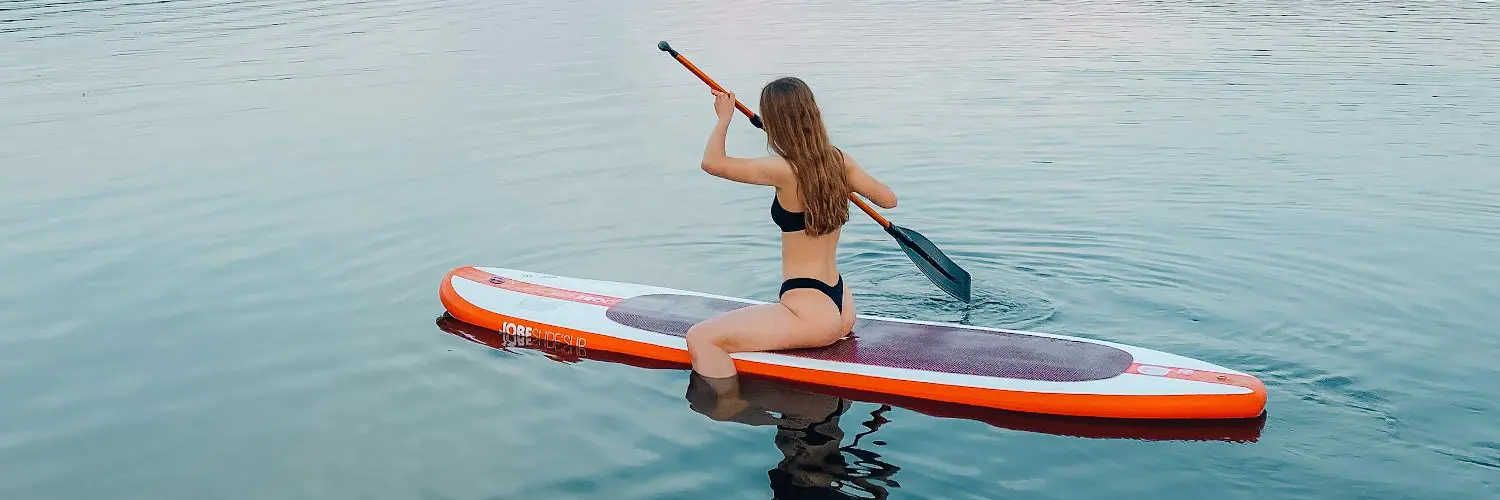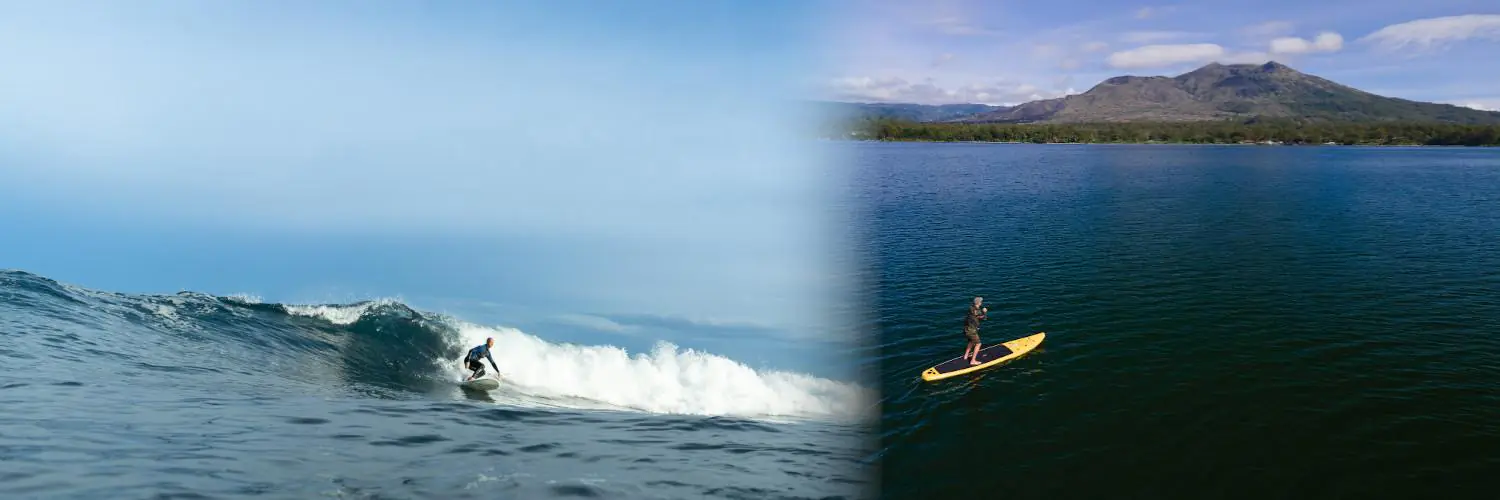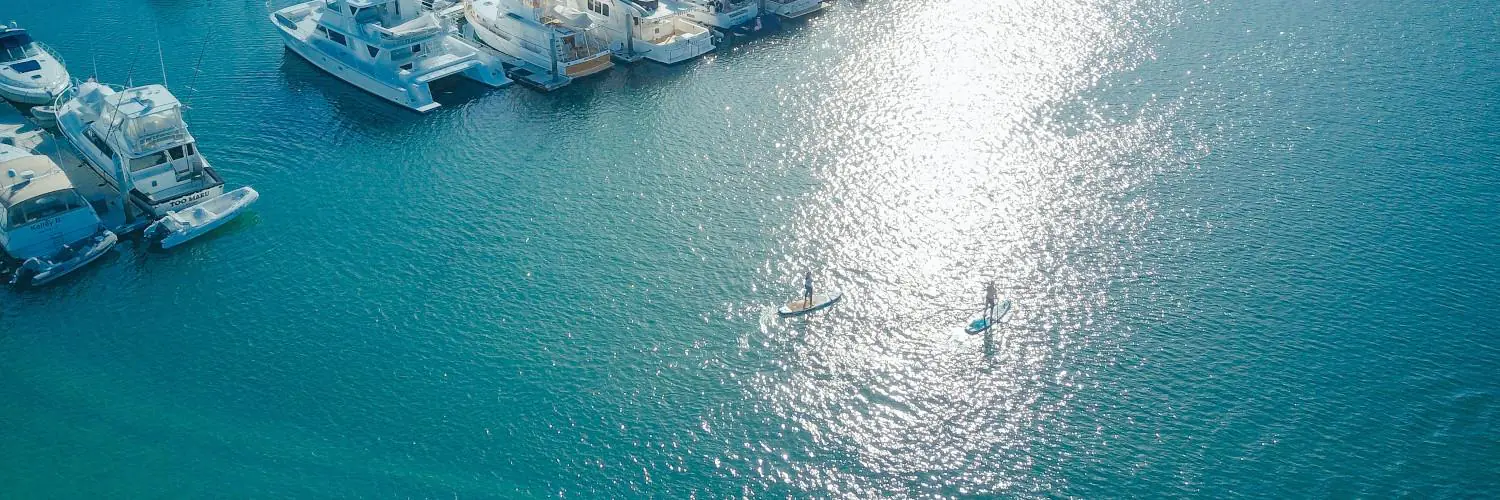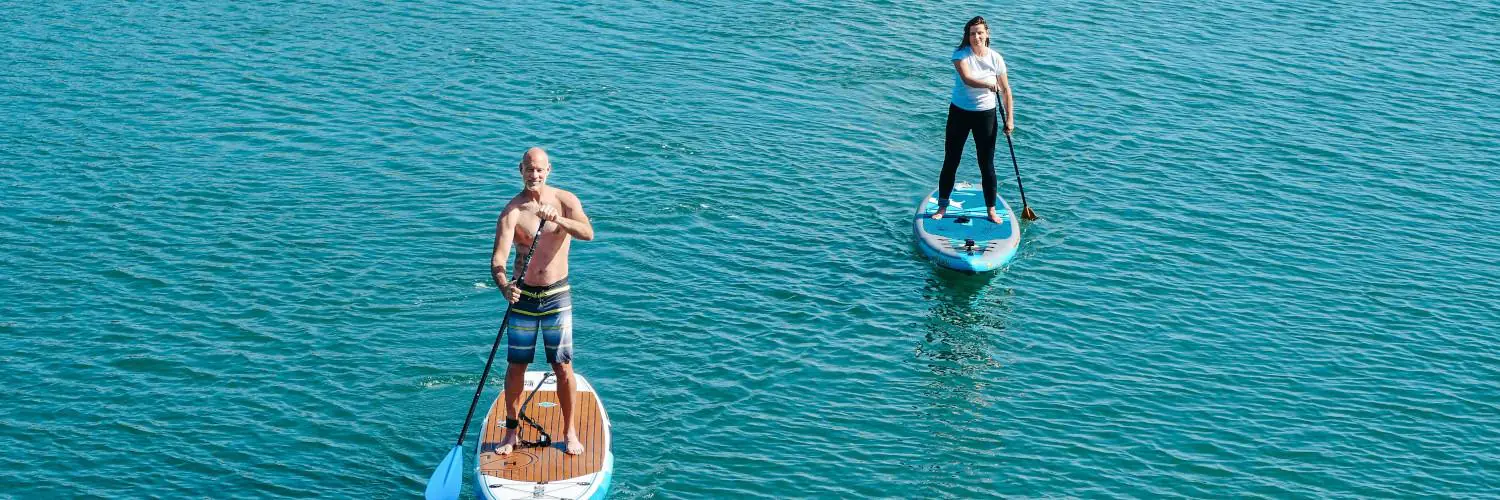Selecting the right stand up paddle board (SUP) is essential for both beginner and seasoned paddlers. SUP length is a critical factor in the performance and handling of the board on the water. Generally, the board’s length influences speed and maneuverability, with longer boards typically providing greater speed and tracking straighter. Shorter boards, on the other hand, are better suited for quick turns and are often preferred for surfing purposes.
When deciding on a SUP, one should consider the intended use. For those looking to catch waves, shorter boards under 10 feet are recommended for their agility. Meanwhile, average users aiming for recreational paddling on flat water might find boards in the range of 10 to 12 feet optimal. These lengths strike a balance between speed and stability and are very versatile for various conditions.
The width of a paddle board also affects its performance, with wider boards offering more stability – ideal for beginners or those using it for fitness and yoga. Generally, the most popular SUP boards are approximately 32 to 34 inches wide. It’s this combination of length and width that determines not just stability and speed, but also how suitable a board will be for the paddler’s size, skill level, and activities. Thus, potential SUP owners should carefully assess these dimensions to ensure their paddling experience is both enjoyable and aligned with their goals on the water.
Table of Contents
Choosing the Right SUP
Selecting the right stand-up paddleboard (SUP) requires understanding the precise interplay of board dimensions with the rider’s height, weight, and intended use. It’s not just about the board’s size; the shape, volume, and even the width play crucial roles in ensuring optimum stability and performance.
Understanding SUP Sizes and Shapes
Board Length: The length of a SUP affects its speed and maneuverability. Generally, boards range from 10 to 12 feet. Shorter boards are more maneuverable, making them ideal for surfing. Longer boards, however, offer better glide and speed, which is preferred for touring and racing.
Board Width: Stability is heavily influenced by the width of the paddleboard. A typical board might have a width between 31 to 33 inches. Wider boards offer greater stability, which is especially beneficial for beginners.
Thickness and Volume: A SUP’s buoyancy is largely a function of its thickness and overall volume. A thicker board, around 5 to 6 inches, can support more weight—a crucial consideration for larger riders.
- Shape: The shape of the SUP plays a pivotal role in its performance.
- Planing Hull: Similar to a surfboard, it’s designed for flat waters and wave riding.
- Displacement Hull: With a pointed nose, it cuts through water and is meant for long distances and racing.
SUP Boards for Different Activities
For Leisure and Yoga: One should look for a board that provides a stable platform. These boards are typically longer and have a planing hull for better balance.
For Surfing: Riders need a shorter board with a planing hull, which allows for swift cuts and turns in the surf.
For Touring:
- A longer and narrower board with a displacement hull is preferred for touring, as it enhances tracking and speed over long distances.
For Racing:
- A racer would opt for the longest, narrowest board with a displacement hull for peak performance.
Weight Capacity: Matching a rider’s weight to the SUP’s volume and weight capacity ensures the board performs as intended. Higher volume usually translates to more weight capacity and a more stable ride.
Through careful consideration of these factors, paddlers can select a SUP that best fits their body type and desired paddling activities, ensuring a satisfying experience on the water.
Types of SUP Boards
The selection of Stand-Up Paddle (SUP) boards caters to various activities and skill levels, with the primary distinction between inflatable and hardboard options. Design and construction have evolved to offer specific performance characteristics for activities such as surfing, racing, and yoga.
Inflatable vs Hardboard
Inflatable SUPs
- Material: Typically made from PVC with a drop-stitch construction that allows them to be inflated to high pressures for rigidity.
- Advantages: Highly portable, often coming with a backpack for transportation, and generally more affordable.
- Disadvantages: Can be less performance-oriented than hardboards.
Hardboard SUPs
- Material: Constructed from a variety of materials including foam, fiberglass, carbon fiber, or wood.
- Advantages: Better performance in terms of glide and stability, preferred for intensive use and in competitive scenarios.
- Disadvantages: Less convenient to transport and usually more expensive.
Specialized SUPs for Surfing, Racing, and More
Surfing SUPs
- Design: Shorter in length with a planing hull, these SUPs are nimble and responsive for wave-riding.
- Usage: They require more skill to balance and are ideal for those looking to perform maneuvers similar to traditional surfing.
Racing SUPs
- Design: Long and narrow with a displacement hull for cutting through water. These boards provide speed and efficiency.
- Ideal For: Paddlers interested in competition and speed, made of lightweight materials for optimal performance.
Yoga SUPs
- Features: These include a wide deck for stability and a soft top for comfort while performing yoga poses.
- Notice: Often included are attachments for securing gear and anchoring the board during yoga sessions.
Touring SUPs
- Attributes: Longer, with ample storage space. Designed to maintain a straight tracking and efficient glide over longer distances.
- Intended For: Paddlers desiring exploration and adventure over bodies of water, a purposeful choice for extended journeys.
Recreational SUPs
- Characteristics: Versatile, with a balance of stability, width, and length, suitable for all levels.
- Suitable For: Casual use, including short excursions and family fun on lakes and calm coastal areas.
Manufacturers optimize dimension combinations to enhance the SUP board’s performance in its intended environment while ensuring proper flotation and stability. Each type of board facilitates a particular paddling experience, from tranquil yoga sessions to the adrenaline rush of racing or surfing.
Paddles and Paddling Technique
The effectiveness of stand-up paddleboarding hinges on selecting the right paddle and employing proper paddling technique. Achieving optimal paddle length and refining one’s form are critical for efficiency and comfort.
Choosing the Right Paddle
The size of a SUP paddle is paramount and should be tailored to the user’s height and paddling style. It is typically recommended that the paddle length be about 6-8 inches above the user’s head for general paddling, with adjustments for specific activities. Paddle sizing methods include:
- Laird Hamilton method: Align the paddle with the paddler’s height and add 3-4 inches.
- Extended Arm Approach: The paddle’s handle should just reach the inside of the paddler’s wrist when their arm is fully extended upwards.
Adjustable paddles offer versatility as they can be altered to suit different user heights and paddling conditions.
Material plays a role in performance and weight; options range from aluminum, which is affordable and durable, to carbon fiber, favored for its light weight and responsiveness.
Perfecting Paddling Form
Proper technique is crucial for efficient SUP paddling. A paddler’s stance should be shoulder-width apart for stability, and their reach should maximise the use of each stroke. Key points of the technique include:
- The paddle shaft should be held vertically during strokes for optimal tracking and reduced drag.
- Initiating the stroke with the shoulder and torso, not just the arms, engages the core muscles for power.
- The blade of the paddle should cut into the water cleanly to prevent unnecessary splash and resistance.
A paddler should always adapt their paddling style to the conditions they are in, ensuring efficiency and reducing fatigue.
SUP Accessories and Gear
Paddleboarding enthusiasts know that the right accessories and gear can elevate their experience on the water. From ensuring safety and buoyancy to simplifying storage and maintenance, a well-equipped paddleboarder is prepared for any adventure.
Essential Accessories for SUP
Pumps: A quality pump is indispensable for inflatable paddleboards. Electric pumps, like the SHARK II ELECTRIC SUP PUMP, offer convenience, inflating boards up to 20 PSI rapidly, while manual pumps provide a reliable backup or budget-friendly option.
Buoyancy: Personal flotation devices (PFDs) are crucial for safety. Riders should select a life jacket or belt PFD that meets local regulations and comfortably supports their weight capacity.
Deck Pad: The deck pad is pivotal for grip and comfort while standing. It should be non-slip, durable, and cover a significant portion of the board’s surface for optimal performance.
Paddles: Paddles come in adjustable or fixed lengths, with materials ranging from aluminum to carbon fiber. A paddle’s weight and stiffness influence the control and energy required for paddling.
- Safety Gear: Leashes tether the rider to the board, preventing separation.
- Accessories for Convenience: Waterproof phone cases and drink holders enhance the usability of the paddleboards.
Storage and Maintenance
Storage Solutions:
- Board Bags: Protect paddleboards from scratches and UV damage.
- Racks and Mounts: Secure paddleboards during transport and storage, accommodating the board’s maximum capacity.
Maintenance Gear:
- SUP Socks: These soft covers shield against dents when not in use.
- Cleansers and Repair Kits: Regular cleaning preserves the board’s integrity, and repair kits ensure any damage can be addressed promptly.
Purchasing and Recommendations
When selecting a stand-up paddleboard (SUP), buyers should consider their skill level, intended use, and body weight to guide their choice. The proper SUP size can enhance one’s paddling experience, offering a mix of stability, maneuverability, and speed that suits their needs.
Selecting a SUP for Your Needs
For beginners, a longer and wider SUP typically ranges from 10 to 12 feet in length and about 31 to 35 inches in width, providing stability and ease of control. Beginners should focus on boards that offer sufficient buoyancy and stability, which is directly related to the board’s volume and weight capacity. It’s essential to choose a board with a maximum weight capacity above the paddler’s body weight.
Advanced paddlers might prefer a shorter board for increased maneuverability in surf or a streamlined, narrower board for racing and touring. Boards under 10 feet in length cater to children and those looking to surf waves, while touring boards may extend to 12’6" for better speed and straight-line tracking.
| Skill Level | Board Length | Board Width | Usage |
|---|---|---|---|
| Beginner | 10 – 12 feet | 31 – 35 inches | General/All-around |
| Intermediate | 10 – 12 ½ feet | 31 – 32 inches | Speed/Tracking |
| Advanced | 9’6" – 12’6" | 26 – 32 inches | Racing/Touring/Specialized |
Where to Buy and What to Expect
Stand-up paddleboards are available at outdoor recreation stores, specialty surf shops, and online retailers. REI Co-op and ISLE Surf & SUP are examples of stores that offer a range of SUPs suitable for different experience levels and activities. When purchasing a SUP, customers should expect to find detailed product specifications and paddle board size charts to aid in making an informed decision.
Prospective buyers should inquire about the complete package, including essential accessories like paddles, which sometimes need to be sized to the paddler’s height and the board’s width. Before making a purchase, checking return policies and warranty options is advisable. Buyers can also look for expert advice, recommendations, and online reviews to support their decision-making process.
Physical stores may provide the added benefit of hands-on guidance, while online purchases can offer the convenience of direct delivery, potentially with more competitive pricing. However, when purchasing online one should consider the shipping costs and the potential difficulty of returning a large item like a SUP if it doesn’t meet expectations.








